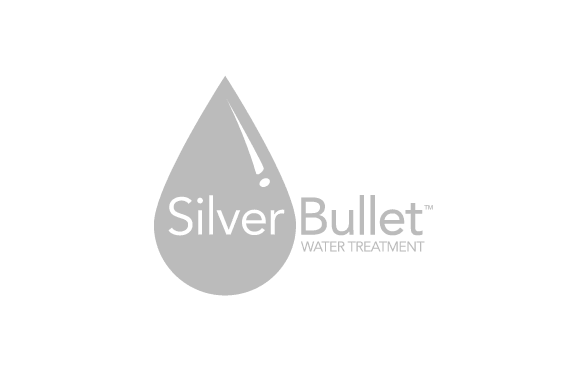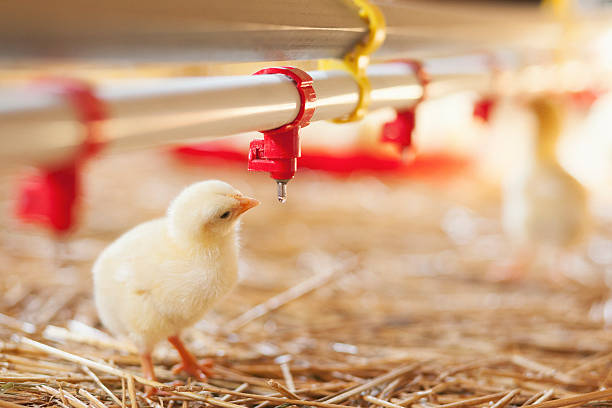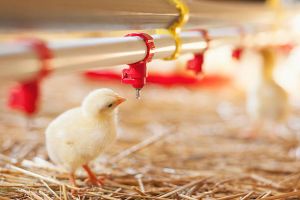Do you know what’s in your poultry drinking water? Despite its foundational role in poultry health, poultry water sampling and quality are often overlooked. On many poultry farms, it’s alarmingly common to find water supplies contaminated with pathogens, bacteria, metals and microorganisms. Substandard poultry water quality can significantly impair poultry performance, affecting everything from growth rates to overall health.
Poorly managed poultry drinking water can devastate animal immunity, growth, reproduction and overall health. Our communities rely on healthy livestock farming to produce essential products like meat, eggs and dairy. For farmers, the quality of water goes beyond animal welfare — it’s critical for their livelihood.
Today’s top poultry farmers, who understand the critical role of drinking water, implement two key methods to ensure optimal conditions for poultry health. These methods not only safeguard the well-being of the poultry but also provide farmers with peace of mind through preventative risk avoidance.
The 2 Best Practices for Poultry & Livestock Drinking Water
Water is a necessity of life. Having quality water is imperative for anyone and any living thing. Implementing a routine schedule for microbial and mineral water analysis is crucial for identifying alterations in water quality management. This practice holds particular significance in animal environments, where bacterial contamination directly affects animal health. Regular monitoring ensures timely intervention and safeguards the well-being of the animals.
Whether it’s poultry, swine, cattle, or sheep, your water quality is fundamental to animal health, growth and quality. This is where best-practice water treatment technologies, like AOP, come into play.
1. Poultry AOP Drinking Water Treatment
Advanced oxidation process (AOP) has become the most effective treatment method designed to eliminate contaminants and pathogens effectively. This process involves the generation of highly reactive hydroxyl radicals, which oxidize and break down organic and inorganic pollutants in water. AOP is particularly beneficial for agricultural settings, where water quality is directly linked to the health of crops and livestock.
2. Poultry Drinking Water Sampling & Testing
To ensure the efficacy of AOP water treatment and to address potential water quality issues, proper sampling is paramount. Water sampling involves collecting samples from specific locations to analyze various parameters, including pH, dissolved oxygen and the presence of bacteria. Taking accurate and representative samples is crucial for identifying potential contaminants and ensuring the success of any water treatment process.
Why Compare Baseline & End-of-Line Water Samples?
When choosing to sample directly from the water source, the primary goal is to establish a baseline understanding of the water quality in its natural state. This method provides a snapshot of the initial conditions, allowing for the identification of any inherent contaminants present in the raw water. For agricultural systems relying on natural water sources like rivers, ponds or wells, this type of sampling is crucial for assessing the quality of the water before any external influences come into play.
Baseline Water Sampling
Water source sampling serves as a baseline for evaluating changes in water quality over time. By understanding the baseline conditions, farmers and water managers can more accurately identify deviations caused by external factors such as weather events, industrial runoff, or changes in land use.
1. Early Contaminant Identification
Detecting potential contaminants at the source enables proactive measures to mitigate risks. Whether it’s addressing high levels of nutrients, heavy metals, or microbial content, early identification allows for the implementation of targeted interventions to safeguard both livestock and crops.
2. Transportation and Distribution Risks
Understanding the initial water quality is crucial for assessing the risks associated with water transportation and distribution. Contamination can occur during these processes, and by knowing the baseline, farmers can implement proper handling procedures and ensure that the water reaching the end of the line is as clean as possible.
End-of-Line Water Sampling
On the other hand, sampling at the end of the line, which could be an animal watering trough or the final point of irrigation, provides insights into the quality of water that directly impacts animals or crops. This type of sampling is instrumental in evaluating the effectiveness of on-site water treatment measures and identifying any potential contamination that may have occurred within the system.
1. Assess Treatment Effectiveness
For agricultural operations employing on-site water treatment technologies like AOP, end-of-line sampling allows for an assessment of treatment effectiveness. It provides a real-world measure of the water quality that animals or crops are exposed to after undergoing any purification processes.
2. System Integrity Check
Sampling at the end of the line serves as a check on the integrity of the water distribution system. It helps identify any issues, such as leaks, cross-contamination, or biofilm formation, that may compromise the quality of water delivered to the intended recipients.
3. Animal and Crop Exposure
Ultimately, the quality of water at the end of the line directly influences the health and well-being of livestock, poultry and crops. This type of sampling ensures that the water reaching its destination meets the necessary standards, minimizing the risk of waterborne diseases in animals and preventing potential harm to crops.
4. Response to Dynamic Conditions
End-of-line sampling is particularly valuable in dynamic agricultural systems where water quality may change due to factors like temperature fluctuations, variations in water demand, or the introduction of new contaminants. Regular sampling at the point of use allows for adaptive management practices in response to these changing conditions.
Baseline water sampling evaluates contaminants in supply water, while end-of-line water sampling evaluates post-treatment water quality that nourishes livestock, poultry or crops. Using both approaches gives you a comprehensive water quality health check – so you can make informed, data-backed water management decisions.
How to Collect Your Water Samples
Consistency in sampling locations is paramount when monitoring water quality in agricultural settings. Whether it’s a livestock watering point or an irrigation outlet, sampling from the same spot allows for accurate tracking of changes over time. This consistency is especially critical when comparing results and implementing water treatment technologies, like AOP.
1. Selecting the Sampling Point
Choose a sampling point that accurately represents the water source. This might be a watering trough for livestock, poultry or a specific irrigation point for crops. Consistency in sampling location is key to monitoring changes in water quality over time.
2. Use Sterile Equipment
Sterilize all sampling equipment before use to prevent contamination. This includes bottles, tubes and any tools used in the sampling process. Sterile gloves should also be worn to minimize the risk of introducing external contaminants.
3. Depth Matters
When collecting samples from a natural water source, such as a river or pond, consider sampling at different depths. Water quality can vary with depth due to factors like temperature stratification, and sampling at various levels provides a more comprehensive analysis.
4. Avoid Cross-Contamination
Take care to avoid cross-contamination during the sampling process. Use separate equipment for each sampling point and ensure that there is no contact between the sampled water and the surrounding environment.
How to Ship Your Water Samples
Once samples are collected, proper handling and shipping are essential to maintain the integrity of the data obtained. Follow these best practices when shipping water samples:
1. Secure Packaging
Use leak-proof and durable containers to prevent spillage during transit. Ensure that the lids are tightly sealed to avoid contamination.
2. Proper Labeling
Clearly label each sample with information such as the sampling date, location and any relevant details about the water source. Accurate labeling is crucial for data interpretation.
3. Temperature Control
Some parameters, such as bacterial content, may be sensitive to temperature changes. Consider using coolers or ice packs to maintain the desired temperature during shipping.
Peace-of-Mind Poultry Protection
Implementing advanced water treatment technologies like AOP, coupled with thorough and consistent water sampling, provides a robust framework for managing water quality in agricultural settings. These practices not only enhance animal health and crop yields but also equip farmers with the tools necessary for proactive water management. These technologies are crucial for eliminating contaminants effectively.
Consistent water sampling is vital, serving as the foundation for applying AOP effectively. It allows for a detailed understanding of water conditions and targeted treatments that address specific water quality issues. Furthermore, incorporating bacterial analysis helps identify and mitigate risks from pathogens like E. coli and Salmonella, protecting both animal health and consumer safety.
By consistently applying advanced water treatment and monitoring technologies, agriculture can achieve a sustainable future, ensuring the health of animals, the yield of crops and the conservation of water resources — all in harmony.
Whether you’re managing poultry, dairy, swine or cattle, a detailed drinking water quality testing unlocks the full potential of your livestock health and production. Say goodbye to guesswork and start making informed livestock decisions with confidence.







